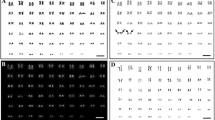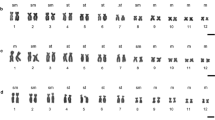Abstract
C-band patterns of some Odontophrynus species from Brazil are described. O. americanus 2n and 4n are cryptic species similar to 0. cultripes 2n, but their C-banding patterns are different. In O. americanus 2n the C-band appears at the secondary constriction of chromosomes 4. In O. americanus 4n and 0. cultripes the C-band appears at the secondary constriction of chromosomes 11. 0. cultripes chromosomes 2. 3 and 6, have also an intercalary band. Furthermore, fine centromeric bands in several weeks old preparations of these species were observed. The possibility of a structural or chemical heterogeneity of those heterochromatic regions is discussed.
Similar content being viewed by others
References
Arrighi, F. E., Hsu, T. C.: Localization of heterochromatin in human chromosomes. Cytogenetics 10, 81–86 (1971)
Beçak, M. L., Beçak, W.: Studies on polyploid amphibians. Karyotype evolution and phylogeny of the genus Odontophrynus. J. Herpetology 8, 337–341 (1974)
Beçak, W.: Genic action and polymorphism in polyploid species of Amphibians. Genetics 61, Suppl. 183–190 (1969)
Beçak, W., Goissis, G.: DNA and RNA content in diploid and tetraploid amphibians. Experientia (Basel) 27, 345–346 (1971)
Beçak, W., Pueyo, M. T.: Gene regulation in the polyploid amphibian Odontophrynus americanus. Exp. Cell Res. 63, 448–451 (1970)
Bianchi, N. O., Bianchi, M. S., Vidal-Rioja, L.: Heterochromatin late replication and secondary constrictions in the chromosome complement of Leptodactylus ocellatus. Caryologia (Firenze) 26, 397–403 (1973)
Fiskesjö, G.: Two types of constitutive heterochromatin visible in Allium by a rapid C-banding method. Hereditas (Lund) 78, 153–156 (1974)
Funaki, K., Matsui, S., Sasaki, M.: Location of nucleolar organizers in animal and plant chromosomes by means of an improved N-banding technique. Chromosoma (Berl.) 49, 357–370 (1975)
Klášterská, I., Natarajan, A. T.: Distribution of heterochromatin in the chromosomes of Nigella damascena and Vicia faba. Hereditas (Lund) 79, 154–155 (1975)
Pardue, M. L., Brown, D. D., Birnstiel, M. L.: Location of the genes for 5S ribosomal RNA in Xenopus laevis. Chromosoma (Berl.) 42, 191–203 (1973)
Pilone, G. B., Nardi, I., Batistoni, R., Andronico, F., Beccari, E.: Chromosome location of the genes for 28S, 18S and 5S ribosomal RNA in Triturus marmoratus (Amphibia Urodela). Chromosoma (Berl.) 49, 135–153 (1974)
Schmidtke, J., Beçak, W., Engel, W.: The reduction of genie activity in the tetraploid Odontophrynus americansu is not due to loss of ribosomal DNA. Exp. Cell Res. (in press)
Stack, S. M.: Differential Giemsa staining of kinetochores and nucleolus organizer heterochromatin in mitotic chromosomes of higher plants. Chromosoma (Berl.) 47, 361–378 (1974)
Stock, A. D., Mengden, G. A.: Chromosome banding pattern conservatism in Birds and nonhomology of chromosome banding patterns between Birds, Turtles, Snakes and Am phibians. Chromosoma (Berl.) 50, 69–77 (1975)
Author information
Authors and Affiliations
Rights and permissions
About this article
Cite this article
Ruiz, I.R.G., Beçak, W. Further studies on polyploid amphibians. Chromosoma 54, 69–74 (1976). https://doi.org/10.1007/BF00331834
Received:
Accepted:
Issue Date:
DOI: https://doi.org/10.1007/BF00331834




